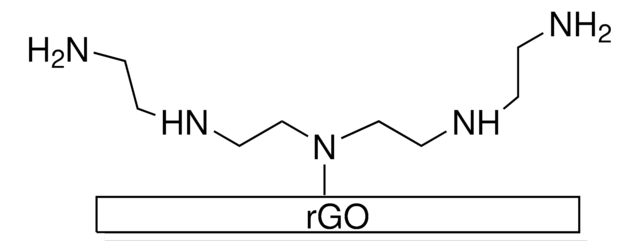777684
Reduced graphene oxide
Sinônimo(s):
rGO
About This Item
Produtos recomendados
descrição
chemically reduced
forma
powder
composição
Carbon, ≥75 wt. %
Nitrogen, >5 wt. %
Oxygen, <22 wt. %
área da superfície
450 m2/g
condutividade
>600 S/m
solubilidade
water: insoluble
Procurando produtos similares? Visita Guia de comparação de produtos
Categorias relacionadas
Descrição geral
Aplicação
- chemical sensors, biosensors
- as transparent electrodes in light emitting diodes (LEDs) and ITOs
- in lithium ion batteries.
Nota de preparo
- Reduction method: Chemically reduced
- Color: Black
- Odor: Odorless
- Solubility: Insoluble
- Dispersability: It can be dispersed at low concentrations (<0.1mg/mL) in NPM, DMSO, DMF
- Electrical conductivity: > 600S/m
- BET surface area: 450 m2/g
Código de classe de armazenamento
11 - Combustible Solids
Classe de risco de água (WGK)
WGK 3
Ponto de fulgor (°F)
Not applicable
Ponto de fulgor (°C)
Not applicable
Certificados de análise (COA)
Busque Certificados de análise (COA) digitando o Número do Lote do produto. Os números de lote e remessa podem ser encontrados no rótulo de um produto após a palavra “Lot” ou “Batch”.
Já possui este produto?
Encontre a documentação dos produtos que você adquiriu recentemente na biblioteca de documentos.
Artigos
Graphene oxide, a monomolecular layer of graphite with oxygen functionalities, holds unique properties valuable for various applications in materials science.
3D printing is a type of additive manufacturing that can be used to rapidly fabricate components with highly customizable geometries.
Fluorescence quenching microscopy visualizes 2D materials like graphene and MoS2 rapidly, inexpensively, and with high fidelity.
Since its discovery little more than a decade ago,1 the two-dimensional (2D) allotrope of carbon—graphene—has been the subject of intense multidisciplinary research efforts.
Nossa equipe de cientistas tem experiência em todas as áreas de pesquisa, incluindo Life Sciences, ciência de materiais, síntese química, cromatografia, química analítica e muitas outras.
Entre em contato com a assistência técnica





